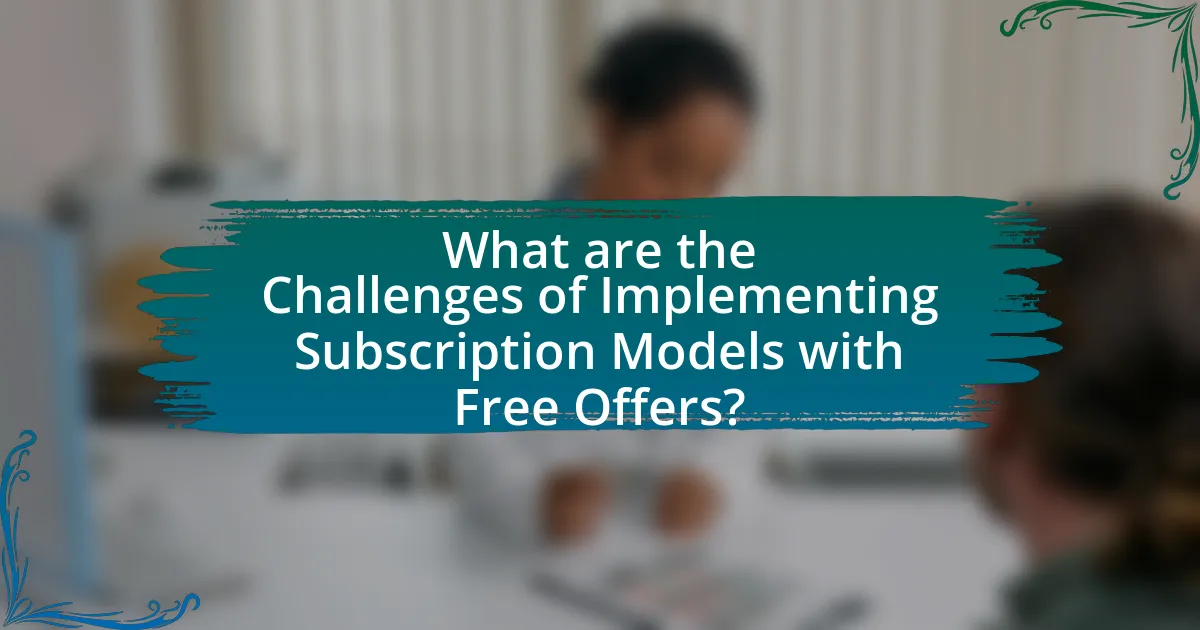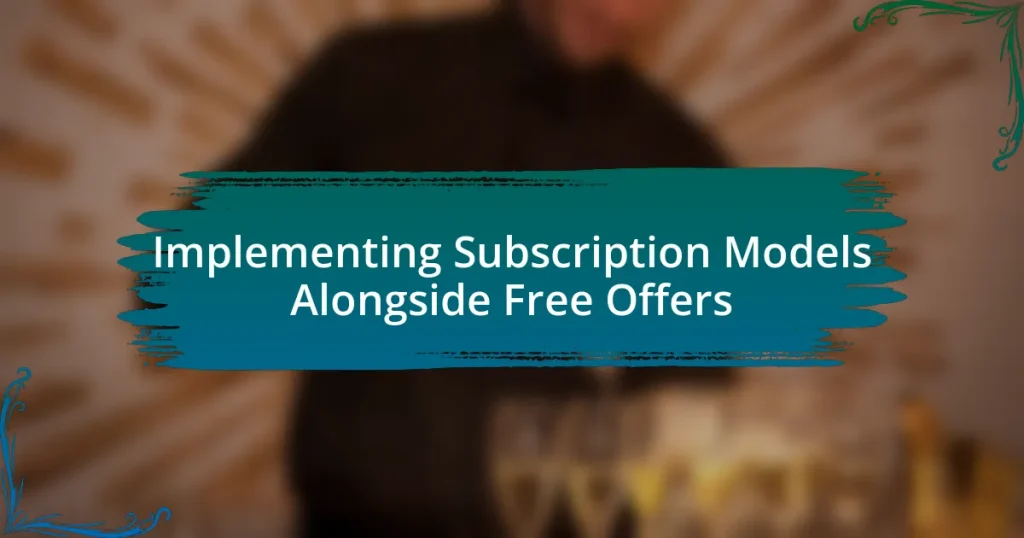The article focuses on the implementation of subscription models alongside free offers as a strategic approach for businesses. It defines subscription models as recurring payment systems that foster customer loyalty and generate consistent revenue, while free offers serve as promotional tools to attract users. Key differences between the two models are highlighted, including revenue potential and customer engagement strategies. The article also discusses market trends, consumer preferences, challenges in balancing both models, and best practices for successful implementation, emphasizing the importance of clear value communication and customer feedback in optimizing subscription offerings.

What are Subscription Models and Free Offers?
Subscription models are business strategies where customers pay a recurring fee to access a product or service, while free offers are promotional tactics that provide products or services at no cost to attract potential customers. Subscription models generate consistent revenue and foster customer loyalty, as evidenced by the growth of companies like Netflix and Spotify, which have millions of subscribers. Free offers, such as trials or freemium services, serve as entry points for users, allowing them to experience the value of a service before committing financially, a strategy successfully employed by companies like Dropbox and LinkedIn to increase user acquisition and conversion rates.
How do subscription models differ from free offers?
Subscription models require users to pay a recurring fee for access to products or services, while free offers provide access without any payment. Subscription models often include additional features, exclusive content, or enhanced customer support that are not available in free offers. For instance, a study by McKinsey & Company found that subscription services can generate 5 to 10 times more revenue per user compared to free models, as they create a steady income stream and foster customer loyalty. This financial structure incentivizes businesses to invest in quality and innovation, differentiating them from free offerings that may rely on advertising or limited features.
What are the key characteristics of subscription models?
Subscription models are characterized by recurring payments for access to products or services over a specified period. These models typically include features such as predictable revenue streams, customer retention through ongoing engagement, and tiered pricing structures that cater to different user needs. For instance, companies like Netflix and Spotify utilize subscription models to ensure consistent cash flow while providing users with continuous access to content. Additionally, subscription models often incorporate free trials or freemium options to attract new customers, allowing them to experience the service before committing financially. This approach has been shown to increase conversion rates, as evidenced by a study from Zuora, which found that businesses using subscription models experienced a 5-10% increase in customer retention compared to traditional sales models.
What are the advantages of free offers for businesses?
Free offers provide significant advantages for businesses, primarily by attracting new customers and increasing brand awareness. By offering products or services for free, businesses can lower the barrier to entry for potential customers, leading to higher engagement rates. For instance, a study by the Journal of Marketing Research found that free trials can increase conversion rates by up to 20%, as customers are more likely to try a product without financial commitment. Additionally, free offers can generate valuable customer data and feedback, enabling businesses to refine their offerings and improve customer satisfaction. This strategy not only enhances customer loyalty but also fosters word-of-mouth marketing, as satisfied customers are likely to share their positive experiences with others.
Why are businesses considering subscription models alongside free offers?
Businesses are considering subscription models alongside free offers to create a steady revenue stream and enhance customer loyalty. Subscription models provide predictable income, which can be crucial for financial planning and growth, as evidenced by the fact that companies like Adobe transitioned to subscription services and reported a 22% increase in annual recurring revenue. Additionally, offering free options can attract a larger user base, which can then be converted into paying subscribers, as seen in platforms like Spotify, where free users often upgrade to premium subscriptions for added features. This dual approach allows businesses to maximize their market reach while ensuring sustainable profitability.
What market trends are driving this shift?
The market trends driving the shift towards implementing subscription models alongside free offers include the increasing consumer preference for flexible payment options and the demand for personalized experiences. Research indicates that 70% of consumers prefer subscription services for their convenience and cost-effectiveness, reflecting a broader trend towards recurring revenue models in various industries. Additionally, the rise of digital platforms has enabled businesses to leverage data analytics for tailored offerings, enhancing customer engagement and retention. This trend is supported by the fact that companies utilizing subscription models have reported a 20% increase in customer lifetime value compared to traditional sales approaches.
How do consumer preferences influence this decision?
Consumer preferences significantly influence the decision to implement subscription models alongside free offers by determining the perceived value and willingness to pay for additional features or services. When consumers show a preference for convenience, exclusive content, or enhanced experiences, businesses are more likely to adopt subscription models to meet these demands. For instance, a survey by McKinsey & Company found that 60% of consumers are open to subscription services if they perceive them as providing unique benefits, indicating that understanding consumer preferences directly impacts the strategic decision-making process for businesses.

What are the Challenges of Implementing Subscription Models with Free Offers?
Implementing subscription models with free offers presents several challenges, primarily related to customer acquisition, retention, and perceived value. First, attracting users to convert from free to paid subscriptions can be difficult, as many may become accustomed to the free service and resist paying for additional features. Research indicates that 70% of users who start with a free trial do not convert to a paid plan, highlighting the challenge of demonstrating sufficient value to encourage this transition.
Additionally, maintaining a balance between free and paid offerings can dilute the perceived value of the subscription model. If the free version provides too many features, users may see little incentive to upgrade, leading to lower revenue potential. Furthermore, managing customer expectations becomes complex; users may expect continuous enhancements in the free version, which can strain resources and impact the quality of both offerings.
Lastly, competition in the market can exacerbate these challenges, as numerous alternatives may offer similar free services, making it harder to differentiate and justify the subscription cost. Overall, these factors complicate the successful implementation of subscription models alongside free offers.
What potential pitfalls should businesses be aware of?
Businesses implementing subscription models alongside free offers should be aware of potential pitfalls such as customer confusion, revenue cannibalization, and retention challenges. Customer confusion can arise when the value proposition of the subscription is not clearly communicated, leading to misunderstandings about the benefits compared to free offers. Revenue cannibalization occurs when existing customers opt for free offerings instead of subscribing, negatively impacting overall revenue. Retention challenges may emerge if subscribers do not perceive ongoing value, resulting in high churn rates. According to a study by Zuora, 70% of subscription businesses report that customer retention is their biggest challenge, highlighting the importance of addressing these pitfalls effectively.
How can businesses avoid common mistakes in implementation?
Businesses can avoid common mistakes in implementation by conducting thorough market research and aligning their subscription models with customer needs. Understanding customer preferences and behaviors allows businesses to tailor their offerings effectively, reducing the risk of misalignment. For instance, a study by McKinsey & Company found that companies that invest in customer insights during the implementation phase see a 20% increase in customer satisfaction and retention rates. Additionally, establishing clear communication channels within the organization ensures that all stakeholders are aligned on goals and processes, further minimizing errors during implementation.
What impact do free offers have on subscription uptake?
Free offers significantly increase subscription uptake by lowering the barrier to entry for potential customers. Research indicates that offering free trials or freemium models can lead to higher conversion rates; for instance, a study by McKinsey found that companies using free trials saw conversion rates as high as 25%. This strategy allows users to experience the service without financial commitment, fostering trust and familiarity, which are critical factors in decision-making. Additionally, a report from HubSpot revealed that 70% of consumers are more likely to subscribe after experiencing a free offer, demonstrating the effectiveness of this approach in driving subscription growth.
How can businesses effectively balance subscription models and free offers?
Businesses can effectively balance subscription models and free offers by strategically segmenting their offerings to cater to different customer needs. By providing a tiered structure, businesses can attract a wider audience; for instance, offering basic features for free while reserving premium features for subscribers. This approach not only enhances user acquisition but also encourages free users to convert to paid subscriptions as they recognize the added value. Research indicates that companies like Spotify and Dropbox have successfully implemented this model, with Spotify reporting that over 40% of its users convert from free to paid subscriptions, demonstrating the effectiveness of this strategy in driving revenue while maintaining a free user base.
What strategies can be employed to create synergy between the two models?
To create synergy between subscription models and free offers, businesses can implement tiered service structures that encourage users to transition from free to paid options. This strategy allows users to experience the value of the service at no cost while highlighting premium features available in the subscription model. For instance, offering limited access to premium content or features can entice users to upgrade once they recognize the benefits. Additionally, integrating marketing efforts that promote the advantages of the subscription model, such as exclusive content or enhanced support, can further drive conversions. Research indicates that companies employing tiered models often see increased customer retention and satisfaction, as users feel they are receiving value at every level of engagement.
How can customer feedback shape the balance between subscription and free offers?
Customer feedback can significantly shape the balance between subscription and free offers by providing insights into user preferences and perceived value. When customers express their satisfaction or dissatisfaction with existing offerings, businesses can adjust their subscription models to better align with user expectations, thereby enhancing retention and attracting new users. For instance, if feedback indicates that users find certain premium features essential, companies can emphasize these in their subscription plans while potentially limiting access to less valued features in free offers. This strategic adjustment is supported by research from the Harvard Business Review, which highlights that companies leveraging customer feedback effectively can increase customer loyalty by up to 30%. Thus, actively incorporating customer insights allows businesses to optimize their offerings, ensuring that both subscription and free models meet market demands.

What Best Practices Should be Followed When Implementing Subscription Models with Free Offers?
To effectively implement subscription models with free offers, businesses should prioritize clear value communication, user experience optimization, and strategic conversion pathways. Clear value communication ensures that potential subscribers understand the benefits of the paid subscription compared to the free offer, which can be supported by data showing that 70% of consumers are more likely to subscribe when they perceive clear value (Source: McKinsey & Company). User experience optimization involves creating a seamless onboarding process that encourages engagement with the free offer, as studies indicate that a positive initial experience can increase conversion rates by up to 50% (Source: HubSpot). Lastly, establishing strategic conversion pathways, such as targeted email campaigns or in-app prompts, can effectively guide users from the free offer to a paid subscription, with research showing that personalized marketing can boost conversion rates by 10% to 30% (Source: Epsilon).
How can businesses optimize their subscription offerings?
Businesses can optimize their subscription offerings by analyzing customer data to tailor services and pricing. By leveraging analytics, companies can identify usage patterns and preferences, allowing them to create personalized plans that enhance customer satisfaction and retention. For instance, a study by Zuora found that businesses that utilize data-driven insights to refine their subscription models see a 20% increase in customer retention rates. Additionally, implementing tiered pricing structures can cater to different customer segments, maximizing revenue potential while providing value.
What role does pricing play in the success of subscription models?
Pricing is a critical factor in the success of subscription models as it directly influences customer acquisition, retention, and overall revenue. A well-structured pricing strategy can attract a larger customer base by offering perceived value, while competitive pricing can differentiate a service in a crowded market. For instance, research by Price Intelligently indicates that 70% of consumers are willing to pay more for a subscription service that offers clear value, highlighting the importance of aligning pricing with customer expectations and perceived benefits. Additionally, tiered pricing models can cater to different customer segments, maximizing revenue potential by allowing users to choose plans that fit their needs and budgets.
How can marketing strategies enhance the appeal of subscription models?
Marketing strategies can enhance the appeal of subscription models by effectively communicating value and creating a sense of exclusivity. By utilizing targeted messaging, brands can highlight unique benefits, such as exclusive content or early access to products, which can increase perceived value. For instance, a study by McKinsey & Company found that personalized marketing can lead to a 10-30% increase in conversion rates, demonstrating that tailored approaches resonate more with potential subscribers. Additionally, leveraging social proof through testimonials and user-generated content can build trust and encourage sign-ups, as consumers are more likely to subscribe when they see positive experiences from others.
What are the key metrics to track for success?
The key metrics to track for success in implementing subscription models alongside free offers include customer acquisition cost (CAC), customer lifetime value (CLV), churn rate, conversion rate, and average revenue per user (ARPU). Customer acquisition cost measures the total cost of acquiring a new customer, which is crucial for assessing marketing efficiency. Customer lifetime value estimates the total revenue a customer generates during their relationship with the business, providing insight into long-term profitability. Churn rate indicates the percentage of subscribers who cancel their subscriptions, highlighting retention effectiveness. Conversion rate tracks the percentage of free users who transition to paid subscriptions, reflecting the success of the subscription model. Average revenue per user measures the revenue generated per user, helping to evaluate overall financial performance. These metrics collectively provide a comprehensive view of the effectiveness and sustainability of subscription models in conjunction with free offers.
How can customer retention rates inform business strategies?
Customer retention rates can inform business strategies by indicating the effectiveness of customer engagement and satisfaction initiatives. High retention rates suggest that customers find value in the product or service, which can guide businesses to invest further in those areas, such as enhancing features or improving customer support. Conversely, low retention rates signal potential issues that need addressing, such as product quality or pricing strategies. For instance, a study by Bain & Company found that increasing customer retention rates by just 5% can lead to an increase in profits of 25% to 95%, demonstrating the financial impact of focusing on retention. Thus, analyzing retention rates allows businesses to tailor their strategies to enhance customer loyalty and drive long-term profitability.
What metrics indicate the effectiveness of free offers in driving subscriptions?
The metrics that indicate the effectiveness of free offers in driving subscriptions include conversion rate, customer acquisition cost, and engagement metrics. Conversion rate measures the percentage of users who transition from the free offer to a paid subscription, providing a direct indicator of the offer’s success. Customer acquisition cost assesses the total cost incurred to acquire a new subscriber through the free offer, helping to evaluate the financial efficiency of the strategy. Engagement metrics, such as time spent on the platform and frequency of use, reflect how effectively the free offer captures user interest and encourages ongoing interaction, which can lead to higher subscription rates. These metrics collectively provide a comprehensive view of how well free offers contribute to subscription growth.
What practical tips can businesses implement for success?
Businesses can implement subscription models alongside free offers to enhance customer retention and revenue. By providing a free tier, companies can attract a larger audience, while the subscription model allows for monetization of premium features. Research indicates that businesses utilizing a freemium model see a conversion rate of approximately 2-5% from free to paid subscriptions, which can significantly boost overall profitability. Additionally, offering exclusive content or services to subscribers fosters loyalty and encourages ongoing engagement, leading to a sustainable business growth strategy.


